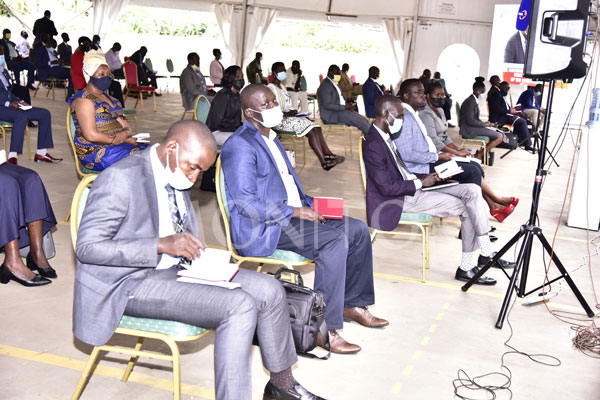Prime
New mining law has potential to curb illicit financial flows – sector analysts

Mr James Muhindo, a mining sector analyst. The draft Bill did not address matters concerning critical minerals which are increasingly becoming of economic interest in light of energy transition.
What you need to know:
Parliament last week concluded the review of the Mining and Minerals Bill, 2021 and thereafter passed it into law. The second step is now for the President to assent to it by signing it into law. As all that plays out, Prosper’s Magazine’s Ismail Musa Ladu sought the views of Mr James Muhindo, a mining sector analyst, on what the new law is seeking to cure.
1. What are your thoughts about the mining sector governance over the last two decades??
To some extent, the country’s mining sector has been on a positive trajectory in the last two decades with large and medium scale companies setting foot in the country to invest in exploration and/or mining of minerals such as cobalt, marble, phosphates, rare earth elements, limestone and gold.
Airborne geophysical surveys undertaken in 2011 indicated over 27 different minerals, including gold, copper, tin, limestone, gemstones, wolfram, cobalt, tin, kaolin, and vermiculite. This is in addition to development minerals such as clay, stone aggregates and sand.
We also have lots of undeveloped resources such as phosphate rock, iron ore, refined lead, niobium (columbium) and tantalum. Our analysis shows that mining in Uganda is carried out by a combination of officially registered mining companies (both local and international) and artisanal and small-scale miners. For that, we need legislations that are robust.
2. So what is your overall perspective of the review resulting into passing of the new Mining and Minerals law by Parliament last week?
The new law just passed by Parliament intends to introduce a new licensing regime that ensures transparency through competitive bidding for brown fields (exploration near or adjacent to an already operating mine making additional capital cost for processing new found ore low) and maintain First Come First Serve process for green fields (mining operation with minimal to no previous exploration). We think that there is need to create a part on reporting on mining revenues just as the case is in the Public Finance Management Act (PFMA) section 60 and 61 on petroleum revenues.
Then on the regulation of the Artisanal and Small-Scale Mining sector: the Mining Act, 2003 does not recognise the Artisanal and Small Scale Miners (ASM) as important players in the mining sector despite contributing over 80 per cent of the minerals production of the country and providing employment for more than 400,000 Ugandans. This Bill provides for organisation, registration, licensing, regulation and transformation of the ASM. This provides an opportunity for ASM formalisation and subsequent contribution to growth of the mining sector. It also enables ASMs to progressively graduate along the mining value chain. This is in line with the Africa Mining Vision of increasing the participation of nationals in the mining sector.
It also introduces Community Development Agreements in Mining Communities. For example, Clause 30, in providing for mineral agreements states that a mineral agreement shall include terms and conditions relating to community benefit sharing and community development, including the obligation to conclude community development agreements with the affected communities of a mining project. This is commendable as it puts communities in a position to negotiate for their development interests and creates harmony between the companies and the communities.
Matters of National Content also stand out: Clause 222 provides that a mineral right, license or permit issued under this Act shall include a commitment by the holder to maximise knowledge transfer to Ugandan citizens and to establish in the country, management and technical capabilities and any necessary facilities for technical work. This provision ensures that the mining sector will have progressive development of human resource that will support the sector’s growth over the years.
The new law further introduces provisions that entrench transparency and accountability in the sector which are not in the current law. The requirement for companies to disclose beneficial owners and for the ministry to publish that beneficial ownership data is important for curbing, money laundering, capital flight and illicit financial flows. This is a positive development which we commend.
3. Is there anything to worry about this proposed law?
We didn’t like the excessive discretionary powers given to the director in the draft bill. One of the challenges the sector is grappling with under the current legal regime is excessive discretionary powers held by the Commissioner for the Geological Survey and Mines department. We have noted in the new law that these discretionary powers have been vested in the hands of the Minister and a tribunal was introduced to check the powers of the director who previously was untouchable.
While the purpose of the new law is to provide a framework for gender mainstreaming, equity and human rights and eradication of child labour in the mining industry, the provisions do not reflect this aspiration. Some provisions potentially allow child labour which we are opposed to.
We would also like to see deliberate alignment of our law to the Africa Mining Vision which is a strategy for integrating the mining sector into broader social and economic development processes for countries on the continent. It calls upon countries to work towards “Transparent, equitable and optimal exploitation of mineral resources to underpin broad-based sustainable growth and economic growth.” It is for this reason that we believe the Bill should be aligned to the Africa Mining Vision, especially in respect to providing for a fiscal regime and the management of revenue from mining.
Then regulation of Building Substances [materials] contrary to Article 244 of the Constitution is something we believe should be re-examined and properly clarified. This is because the new law seeks to bring construction materials under the ambit of the mining sector contrary to Article 244 which states that such building substances are not minerals. There is an ownership question that was not addressed by the draft bill as the constitution provides that all minerals are owned by the Government of Uganda on behalf of the citizens. Construction materials are not classified as minerals thus being owned by landowners, which creates a conflict between mineral rights and land rights.
4. As a parting shot, how do you sum up the new law?
We are alive to the hastiness with which this new law was passed. We don’t think it is alright for Parliament to be rushed by the Executive arm of government into passing legislations of such magnitude. This was the case with East African Crude Oil Pipeline (EACOP) and Public Finance Management Act (PFMA) passed last year to facilitate sector development.
This trend is not helpful at all because it raises procedural concerns as well as suspicions. However, overall we welcome the new legal regime and sincerely hope it will improve the development of the sector, given its critical importance in harnessing, development, jobs, mining revenues as well as protecting the environment from the adverse impacts of mining.





